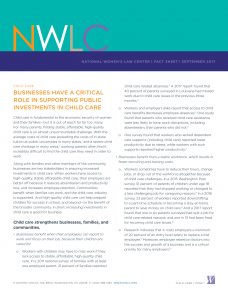Abortion rights, women of color, and LGBTQIA+ people are under attack. Pledge to join us in fighting for gender justice.

Child care is fundamental to the economic security of women and their families—but it is out of reach for far too many. For many parents, finding stable, affordable, high-quality child care is an almost insurmountable challenge. With the average costs of child care exceeding the costs of in-state tuition at public universities in many states, and a severe child care shortage in many areas, working parents often find it incredibly difficult to find the child care they need in order to work.
Along with families and other members of the community, businesses are key stakeholders in ensuring increased investments in child care. When workers have access to high-quality, stable, affordable child care, their employers are better off because it reduces absenteeism and productivity loss, and increases employee retention. Communities benefit when families can work, and the child care industry is supported. And high-quality child care can help prepare children for success in school, and beyond – to the benefit of the broader community. In short, increasing investments in child care is good for business.
Child care strengthens businesses, families, and communities.
- Businesses benefit when their employees can report to work and focus on their job, because their children are cared for.
- Workers with children may have to miss work if they lack access to stable, affordable, high-quality child care. In a 2011 national survey of families with at least one employed parent, 21 percent of families reported child-care related absences. A 2017 report found that 40 percent of parents surveyed in Louisiana had missed work due to child care issues in the previous three months.
- Workers and employers alike report that access to child care benefits decreases employee absences. One study found that parents who received child care assistance were less likely to have work disruptions, including absenteeism, than parents who did not.
- One survey found that workers who lacked dependent care supports (including child care) reported lower productivity due to stress, while workers with such supports reported higher productivity.
- Businesses benefit from a stable workforce, which results in fewer recruiting and training costs.
- Workers sometimes have to reduce their hours, change jobs, or drop out of the workforce altogether because of child care challenges. In a 2015 Washington Post survey, 51 percent of parents of children under age 18 reported that they had stopped working or changed to a less challenging job for caregiving reasons. In a 2016 survey, 23 percent of workers reported downshifting to a part-time schedule or becoming a stay-at-home parent to save money on child care. And a 2017 report found that one in six parents surveyed had quit a job for child care-related reasons, and one in 13 had been fired for recurring child care issues.
- Research indicates that it costs employers a minimum of 20 percent of an entry level salary to replace a lost employee. Moreover, employee retention factors into the success and growth of a business and is a critical priority for many employers.
- Businesses benefit when they can retain their female employees.
- A 2013 survey found that women are more likely than men to leave a job or take a significant amount of time off work to care for a child or other family member. 2008 Census data indicates that more than a third of working mothers do not return to work within the first year after a child’s birth, and another 20 percent of women quit their jobs around the birth of a child. And more recently, in 2015, 56.6 percent of women who gave birth in the prior year were employed, compared to 68 percent of women with children under 18.
- Child care costs consume a substantial portion of women’s income from work. In families whose income are below the poverty level and who pay for child care for children under the age of five, child care costs are, on average, equal to 43 percent of mothers’ income. For families with incomes at or above 200 percent of the poverty level, these child care costs equal, on average, 21 percent of mothers’ incomes. One researcher found that the rising cost of child care has resulted in declining women’s employment—a five percent decline in women’s total employment and a 13 percent decline for working mothers with children under age five.
- As women wait longer to have children, women who leave the workforce for caregiving reasons may be more senior. It is more difficult, and costly, for employers to replace employees with more tenure, experience, and institutional knowledge.
- Communities and local economies are better off when workers have access to, and assistance paying for, high-quality, stable, affordable child care.
- When mothers receive help with the cost of child care, they are more likely to get and keep a job. One study found that single mothers of young children who received help paying for child care were 40 percent more likely to still be employed after two years than single mothers of young children who did not receive any help paying for child care.
- With consistent and sustained employment, working parents are better able to support their families, and contribute to the economy.
- Investments in early childhood education help prepare children in the broader community for success in school and beyond – to the benefit of us all.
- High-quality child care gives children the opportunity to learn and develop skills they need to succeed in school and in life. Studies demonstrate that high-quality child care has positive impacts on children’s cognitive and social development.
- Research points to the conclusion that the earlier the investments in human capital are made, the greater the returns.
- New research shows a 13 percent return on investment (ROI) for comprehensive, high-quality, birth-to-five early education. The research analyzes a wide variety of outcomes, such as health, income, and education.
- Employers and industry leaders have concluded that high-quality early education investments lay the groundwork for the education and training of tomorrow’s workforce, to the benefit of employers.
Child care is a pressing issue for millions of families across the country.
All parents should have peace of mind knowing that they can afford to give their children a safe and healthy learning environment. We need solutions that help workers, businesses, and the community.
- Many families are unable to shoulder the burden of accessing and affording reliable, high-quality child care that fits their families’ schedule and needs alone.
- The high cost of child care and the lack of options create an impossible situation for many families, especially those with low and moderate incomes.
- The average annual cost of full time care for one child ranges from nearly $3,000 to over $17,000, depending on the age of the child, the type of care, and where the family lives. In a 2016 survey, nearly one-third of parents who paid for child care said that child care expenses have caused a financial problem for their household — and of those, more than 70 percent said it was a serious problem. And child care expenses represent a substantially larger share of income for lower-income families than higher-income families.
- One recent report estimated that over half of Americans in the 22 states that were studied live in areas with little or no access to high-quality child care. Rural areas and low-income urban areas are disproportionately likely to be “child care deserts,” and Hispanic/Latino and American Indian and Alaska Native populations are overrepresented in underserved areas.
- In addition, low-income workers, who are more likely to work unpredictable hours or on evenings and weekends, have had even more difficulty finding high-quality child care and early education programs that fit their hours of work. This is particularly important because the five jobs with the largest projected job growth by 2024 are primarily female-dominated and low-wage.
- The high cost of child care and the lack of options create an impossible situation for many families, especially those with low and moderate incomes.
- Businesses can’t solve their employees’ child care challenges alone. Many businesses around the country are aware of their employees’ struggles to find and afford reliable, high-quality child care, and some are able to offer assistance – whether child care on-site or nearby, back-up child care, help finding child care, or the opportunity to put aside pre-tax dollars to use for child and dependent care expenses. But many more employers are unable to do so.
- Almost half of workers in the private sector are employed in small businesses—whose bottom lines are often stretched and who are often unlikely to be able to offer their employees child care assistance. In fact, less than five percent of employees working in businesses with fewer than 50 employees receive any child care assistance at all.
- Larger companies are more likely to offer child care-related benefits, but very few actually provide child care for their employees. Currently, only seven percent of employers with 50 employees or more reported providing child care at or near the worksite to their employees. Over half of employers with 50 or more employees offered Dependent Care Assistance Plans, which allow employees to contribute a portion of their salary to tax-favored accounts that can be used to pay for child and dependent care expenses. Forty-one percent of employers with 50 or more employees offered resource and referral services to help their employees find child care.
- Even when employers are able to offer child care benefits, they may not be able to reach all workers. Low-wage workers—who have the greatest difficulty finding and paying for child care – have extremely limited access to child care benefits at work. While ten percent of private industry workers overall had access to workplace-funded child care, only five percent of workers whose wages were in the bottom 25 percent did so.
We need public investments to provide child care assistance to all families who need it.
- Public investments are an efficient and effective way to address working parents’ struggles with child care. Public investments can have a broad and lasting impact in the community, including by helping to improve the quality of child care settings and on the compensation, education, and training of the child care workforce.
- Critical federal investments in child care that can make a real difference for workers, families and the community include:
- A bold step towards ensuring that high-quality child care is affordable for all families who need it through the Child Care for Working Families Act.
- Immediate new federal investments in the Child Care and Development Block Grant:
- so that child care assistance is available to more eligible low- and moderate-income families who need it;
- to enable states to raise payment rates for child care providers serving families receiving child care assistance, so that the base rate is at least equal to the federally recommended level, with higher rates for higher-quality care; and
- to provide states with the resources needed to implement the important reforms in the program’s 2014 reauthorization.
- Improvements to the federal Child and Dependent Care Tax Credit (CDCTC), such as those proposed in the Child and Dependent Care Tax Credit Enhancement Act of 2017, including:
- Making the CDCTC refundable;
- Increasing the limits on the amounts of child and dependent care expenses used to calculate the credit;
- Increasing the sliding scale used to calculate the credit; and
- Indexing the expense limits and income levels on the sliding scale for inflation.

